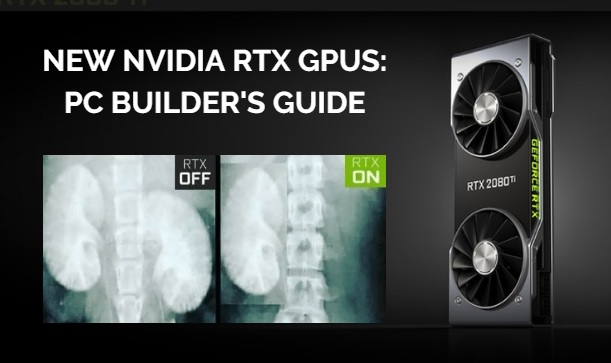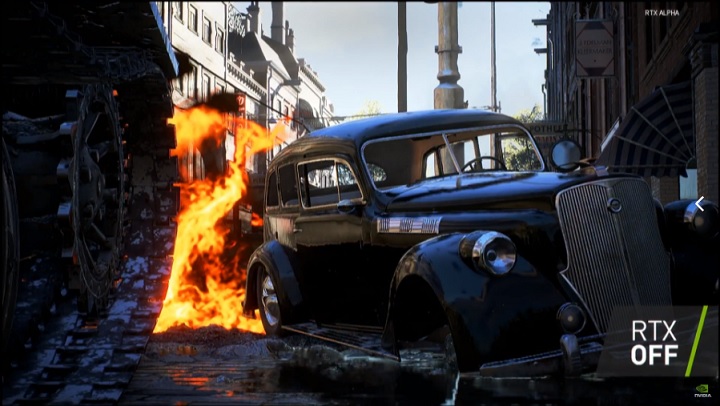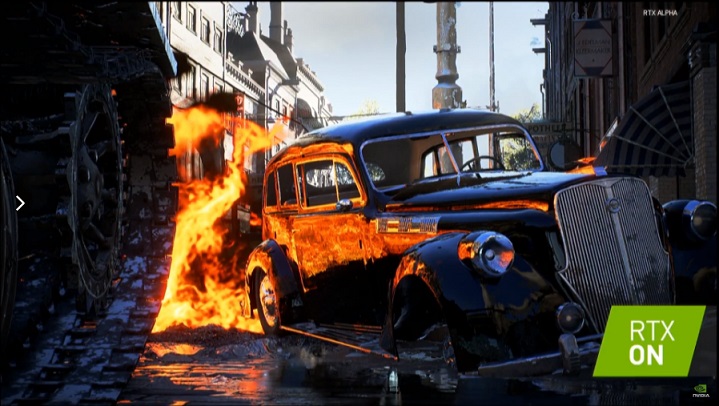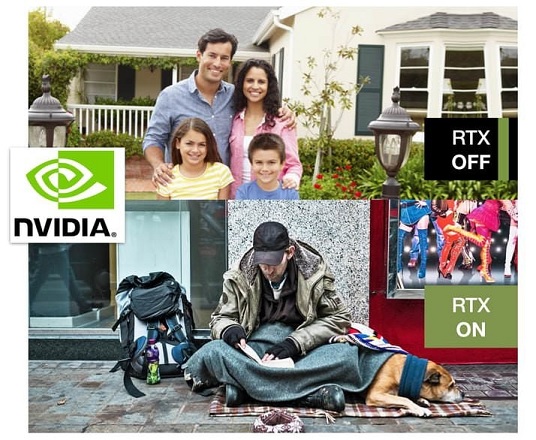
[ad_1]
Home > Best GPUs > RTX 20 Series Launch
Introduction to the New NVIDIA “Turing” RTX Graphics Cards for PC Builders
 Read this guide before selling a kidney for RTX
Read this guide before selling a kidney for RTXPublished: August 28, 2018
It’s finally official. NVidia is releasing their much-anticipated 20 series (or 2000 series however you wanna look at it) gaming graphics cards in September 2018 with a new “Turing” architecture featuring breakthrough rendering features such as real-time ray tracing. NVidia’s worldwide announcement was already around a week ago now, but before posting this breakdown of the new RTX GPUs from the perspective of a cost-effective PC builder I’ve waited a bit until the dust has settled to gather everyone’s thoughts in the industry as well as my own on how to best approach building or upgrading a gaming PC throughout the rest of 2018 with these new “revolutionary” cards now in the mix.
Should you buy the new NVidia RTX cards? How much faster will they be than current-gen GPUs? Should you pre-order them? Should you buy a discounted current-gen 10 series card instead? Good questions, young/not-so-young Padawan. Let’s discuss these things and more if you’re considering buying a new NVidia video card for a new gaming PC build or upgrade this fall/winter (or spring/summer for my Aussies readers).
RTX Models, Specs, Pricing, & Release Dates
GeForce RTX 2080 Ti
Replaces: GTX 1080 Ti
Release Date: September 20th, 2018 (for both founder’s edition and standard models)
Price: $1199 for Founder’s Edition & standard models start from $999
Memory: 11GB GDDR6
CUDA Cores: 4352
Power Required: ~ 250-260W
SLI? Yes (2-way)
Core Clock/Boost Clock: 1350/1545MHz (Founder’s Edition: 1635MHz)
GeForce RTX 2080
Replaces: GTX 1080
Release Date: September 20th, 2018 (for both founder’s edition and standard models)
Price: $799 for founder’s edition & standard models* start from $699
Memory: 8GB GDDR6
CUDA Cores: 2944
Power Required: ~ 265-285W
SLI? Yes (2-way)
Core Clock/Boost Clock: 1515/1710MHz (Founder’s Edition: 1800MHz)
GeForce RTX 2070
Replaces: GTX 1070
Release Date: October, 2018 (TBA)
Price: $599 for founder’s edition & standard models start from $499
Memory: 8GB GDDR6
CUDA Cores: 2304
Power Required: ~ 175-185W
SLI? No
Core Clock/Boost Clock: 1410/1620MHz (Founder’s Editoin: 1710MHz)
- By standard models we mean third-party/partner models such as EVGA, Asus, Gigabyte models etc
- The power required is a bit higher than the previous gen, which is something you may want to factor in when planning your PC build. For example, the RTX 2080 requires 265-285 watts whereas the 1080 only needed around 180 watts.
- All prices are in US Dollars
NVidia has only announced the RTX 2080 Ti, 2080 and 2070 so far, but we know that budget/mid-range models to eventually replace the GTX 1060 and 1050/Ti will likely be announced soon. No prizes for guessing they’ll be named the 2060 and 2050, although we don’t know whether they’ll be part of the RTX family or simply the same old GTX. Unless you’ve been chilling under a rock this past week, all the talk has been about the hefty price tags of the new cards, which are significantly higher priced than previous NVidia launches. We can all only speculate as to why, but most people assume NVidia are doing this simply ’cause they can as they currently dominate the high-end gaming GPU market with no AMD competition in sight (although they’ll inevitably strike back soon enough with their own ray-tracing cards).
What Does the Change from the GTX to RTX Platform Mean?
For a long time NVidia’s gaming graphics cards have been “GTX” cards, but these new soon to be released cards are an all-new “RTX” platform. Why? These new cards, based on an all-new Turing architecture that’s been in the works for 10 years according to NVidia, will introduce real-time ray tracing capabilities to games which we’ll explain a bit more about below. In short this means more realistic, higher-quality 3D rendering in games that are developed with this technology now and into the future, but at what performance cost we’re not sure. The new 20 series RTX cards also introduce new built-in AI/deep-learning capabilities.
“Turing is NVIDIA’s most important innovation in computer graphics in more than a decade and makes possible a new generation of applications that will simulate the physical world at unprecedented speeds. NVIDIA has enhanced its RTX development platform with new AI, ray tracing and simulation SDKs, to take full advantage of Turing’s capabilities. The result? Incredible designs, highly realistic simulations and stunning visual effects —faster than ever before.” – NVidia
How Much Faster is the 20 Series vs the 10 Series?
The million dollar question that right now is anybody’s guess. While we do know the spec improvements, such as the step up in VRAM (video memory) from the GDDR5 of the 10 series to GDDR6, and the expected boost in CUDA cores (eg 21% more cores in the RTX 2080 Ti vs the GTX 1080 Ti), we’re not actually going to know real-world performance differences until the cards are released on September 20 and benchmarkers can do their thing.
Obviously they’ll be a fair bit faster just like with any new GPU launch, but how much faster and whether this performance difference justifies their higher-than-normal-prices-for-a-NVidia-launch is going to be interesting to see come launch week. In their announcement NVidia only showed ray-tracing performance differences compared to the previous cards, which doesn’t mean much at all because the old cards didn’t support ray-tracing anyway.
The closest thing we have to actual performance comparisons of the new cards vs the old ones came from a NVidia blog post soon after their initial announcement shown below, which is very general in nature and shows the 4K performance difference between the RTX 2080 and the GTX 1080, although they did not specify at which settings and they may have only picked certain games that show the 2080 in the best light possible. But yeah, this is all we have until the real benchmarks come out near launch day (perhaps a little earlier if certain sources are allowed to release performance data before the Sept 20 release).
What Does Real-Time Ray Tracing Mean for Games?
Objectively speaking, I don’t know about you but if you also tuned in live to see NVidia’s “biggest announcement in their history” (not my words; one of the NVidia reps/guests at the event said this launch has been in the works for a long, long time) last week then I’m sure you were also a little excited by all the ray-tracing action that went down and the possibilities this new rendering technology holds for the games of the future. If you know how games and rendering works, you’ll understand how much more realistic ray-tracing is than basic rasterization, which is the process used in games today. Without getting too technical here, ray-tracing allows for much more accurate lighting, shadows and reflections in real-time, which makes for more realistic, authentic scenes/moods/ambience.
Ray tracing was always going to be the next frontier in graphics technology for gaming, but hardware is just not at that level right now to make it a reality. But now it’s emerging as a reality for the first time, albeit in a very basic form as chances are it’s going to significantly lower performance and perhaps be something you’ll have to turn off to get the performance you desire at your chosen resolution (HairWorks, anyone?). We’ll have to see how it holds up, though, but I have a feeling that it’s only going to be viable to turn on for 1080p and maybe 1440p if you’re adopting the upper-end of the RTX family and also don’t mind non-flawless performance. Either way, as a graphics geek it’s exciting to see it in gaming for the first time and I’m very intrigued as to how it’s going to perform frame-rate wise.
Of course, the real-time ray tracing capabilities of the new RTX cards will only work in games that are developed with this new technology in mind. Upcoming big releases that do have this include Battlefield 5 and Shadow of the Tomb Raider among others, with plenty more to come. Here’s what standard rasterization vs ray-tracing looks like in Battlefield 5 as shown in NVidia’s RTX announcement speech:


Should You Buy the New 20 Series GPUs?
If the million dollar question is how fast Turing is vs Pascal, the billion dollar question is whether or not you should buy the new generation cards (or buy a discounted current-gen/wait it out until the enxt gen). Personally, if you already have a GTX 1070, 1080 or 1080 Ti I don’t see a real reason to upgrade unless you’re not happy with your performance (or unless money is no object although you probably wouldn’t be reading this if that’s the case). These current-gen GPUs, even the 1070 (or heck, a 1060 if you’re sticking to 1080p), will see you through this first generation of RTX cards, where you could then upgrade when the next cards come out in a couple years or so which will likely have even better ray-tracing.
But if it’s now around time for you to upgrade a system that’s lagging behind, and especially if you want to get in on the new titles to be released later this year (ie Battlefield 5) that will take advantage of the new ray-tracing abilities, I would personally not hesitate to get a new RTX card once released assuming there’s no major revealed flaws upon release. You might also want to consider buying a beasty current-gen card once prices are super-low later this year (it’s inevitable that you’ll find 1080 and 1080 Ti’s at super attractive prices once the new cards are here), but I would definitely lean towards the new RTX range for obvious reasons (who wouldn’t want the latest and greatest when upgrading, right?).
When’s the Best Time to Buy? Should You Pre-Order?
If you’re looking to snag a new graphics card at the best possible price, first of all avoid pre-ordering. Generally speaking, I – and most tech enthusiasts – recommend avoiding pre-ordering new hardware as you just can’t know much about them until they’re released and until extensive, objective testing, benchmarking and comparisons have been done by third parties. Only consider pre-ordering if you absolutely want the cards on day one and you don’t mind spending extra. I’d wait until a good range of partner cards have been released and compared to see which is the best value, and I’d also consider waiting until the end of year sales such as Black Friday and Cyber Monday if you can, although there’s no guarantee of discounts on new cards then. Simply put, besides buying them in a year or so when prices perhaps lower a bit, there’s no telling when the best time to buy is.
Related: Current Best Gaming GPUs
What is the 20 Series Founder’s Edition?
There’s always a lot of confusion surrounding the Founder’s/Reference Edition vs normal/third-party editions of a graphics card, and for good reason as NVidia nor big tech sites never really makes it very clear for us mere mortals to comprehend. Simply put, the Founder’s Edition of the new RTX GPUs are factory-overclocked, meaning they’ll run faster than normal out of the box, as you can see from the clock speeds in the specs above. They also have a unique design and cooling solution, but they’re priced higher. At least in theory: don’t be surprised if partner cards are even more expensive, though. Unless you’re an enthusiast who has clear reasons to get a Founder’s Edition/Reference model, I’d stick with a standard model once they’re released and you can decipher which is best for the money, has the best cooling, features, etc.
20 Series RTX Gaming PC Build Ideas
You can bet your bottom dollar that once the RTX family have been released and benchmarked by the top guns in gaming tech with bigger wallets than I, we’ll assess their bang for buck compared to current-gen cards and include them in our recommended builds where we see fit. At this point I can honestly tell you I don’t know whether I will indeed recommend a 2070, 2080, or 2080 Ti (or all of them) and include them in our build examples, as I think that in terms of maximizing value for your money it’s going to be a close call between buying these new RTX cards and buying a current-gen Pascal (10 series) card as prices of the 1070, 1080 and 1080 Ti are only going to drop once the new cards are out (they already have dropped in recent weeks), and these cards are still powerhouses that will get you through this entire generation of new RTX cards if we’re being honest (and you don’t mind missing out on the first-wave ray-tracing party).
See Also: Current Recommended PC Builds for Gamers
Last Laugh
The hardware world has of course swooped on every detail of every word NVidia has put out over the past week, filled with everything we come to expect from a big tech launch: unconditional fan-boy love and excitement from one side, aggressive negativity and hate from another, and everything in-between including the typical 20,000 ways to ask “should I buy one” from confused non-enthusiasts around the world (good question, tho, ’cause as mentioned over and over the value for money of RTX is still up in the air). Whatever your stance on the upcoming GPU launches and how NVidia is rollin’, you can’t deny the below is solid meme-ry that probably takes the cake over the kidneys above. Thanks to Tipitnow for the laugh.

Trusted Stores
The retailers I recommend most, for the regions that make up the majority of my readers.
USA:
Amazon US /
BestBuy /
Canada: Amazon CA
Australia: Amazon AU /
PLE /
UK: Amazon UK / Overclockers
Disclosure: As an Amazon Associate we earn from qualifying purchases. We may also earn a commission on sales made through other store links (Best Buy, B&H, PLE, and OCUK).
Trusted VPN
VPNs are fast becoming must-have software these days to improve the security and privacy of your PC when online. There’s lots of VPNs but NordVPN is objectively one of the best and the one I use. VPNs also help for online gaming as explained here.
Search Articles
Most Shared
About Me
Indie game programmer currently working on my first official game release (after years of hobby projects), an atmospheric story-driven VR FPS built with Unreal Engine to be announced once I’m ready here and here (for anyone into VR FPS’s). Also likes writing about tech, which helps to fund development of the game.
My favs of all time are OOT, Perfect Dark, MGS1 and 2, GE007, DKC2, THPS3, HL1, WC3, Vice City, and KOTOR, with the most recent addition to my list of immortals being the VR masterpiece Half Life Alyx. If you want help with a new build or upgrade feel free to ask on the main PC builds guide. I try to respond to every comment. – Julz

[ad_2]






